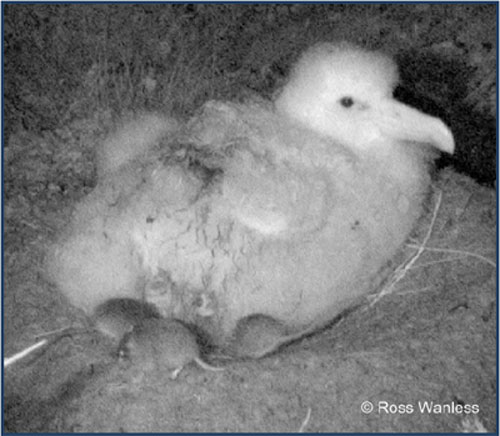The annual relief of the South African weather station on Gough Island in the South Atlantic starts tomorrow with the Antarctic research and supply ship the m.v. S.A. Agulhas II departing Cape Town on Thursday the 5th. Gough forms part of the United Kingdom Overseas Territory of St Helena, Ascension and Tristan da Cunha. South Africa operates the weather station on Gough under a lease arrangement with the Tristan da Cunha Government
Along with the new six-person South African team that will run the station, aboard is a group of marine ornithologists and rope-access technicians that will continue research and monitoring of three species of albatrosses and the Southern Giant Petrel Macronectes giganteus. Alien plant eradication work will continue on the coastal cliffs near the base in Transvaal Bay – hence the need for the climbers.
An important and novel part of the relief will be the presence of Peter Garden, well-known aerial-baiting helicopter pilot, and Keith Broome, Chair of the New Zealand Department of Conservation’s Island Eradication Advisory Group. Their role will be to conduct a trial for the eradication of Gough’s “killer mice” Mus musculus by deploying non-poisoned bait from a helicopter-carried “bait bucket” to assess whether the target baiting density can be achieved on steep, vegetated cliffs so as to present enough bait to every mouse on the island. The climbers, led by frequent visitor to Gough Jan Bradley, will then descend the baited cliffs on fixed ropes counting pellets as they go.
Opportunity will also be taken to fly around and over the island so Peter and Keith can provide their assessments of the feasibility of a full-scale operation (click here for the 2008 feasibility study). These findings will then be used to update the draft preliminary operational plan for eradicating Gough’s mice that was produced in 2010.
In addition, long-term demographic studies will continue on colour-banded populations of four ACAP-listed species that breed on Gough: Critically Endangered Tristan Albatross Diomedea dabbenena (going into its eighth year of study in 2014), Endangered Atlantic Yellow-nosed Albatross Thalassarche chlororhynchos (32nd year in 2013/14), Endangered Sooty Albatross Phoebetria fusca (2nd year of study in 2013/14, following an earlier seven-year study conducted from 1982 to 1990) and the Southern Giant Petrel (fourth year of study). In addition island-wide censuses will be undertaken for Tristan Albatrosses and Southern Giant Petrels.

Mouse attack! This Tristan Albatross chick was dead by the next day
Photograph by Ross Wanless
This year the research and management group will be led by Peter Ryan, Acting Director of the Percy FitzPatrick Institute of African Ornithology, University of Cape Town. ACAP’s Information Officer will be making his 10th visit to Gough since 2007 as part of the team. Also contributing will be Trevor Glass, Head of the Tristan Conservation Department as Relief Environmental Officer.
Two field researchers (Chris Bell and Mara Nydegger from New Zealand) who have spent a year on the island will return with the ship to Cape Town in October at the end of the relief. They will be replaced by three new researchers for the 2013/14 year: Delia Davies, Ben Dilley and Bani van der Merwe.
Click here to read about the start of the 2012 expedition to Gough.
Conservation research on birds and management activities on Gough are funded by the UK's Overseas Territories Environment Programme and the Darwin Initiative Programme via the Royal Society for the Protection of Birds and are conducted with the support and approval of the Tristan Conservation Department and the logistic support of the South African Department of Environmental Affairs.
With thanks to Peter Garden and Peter Ryan for information.
Selected references:
Angel, A. & Cooper, J. 2006. A review of the impacts of introduced rodents on the Islands of Tristan da Cunha and Gough (South Atlantic). RSPB Research Report No. 17. Sandy: Royal Society for the Protection of Birds. 64 pp.
Hilton, G.M. 2007. Workshop Report: Assessing Management Options for the Introduced Rodents of Tristan da Cunha. Unpublished Report to the Royal Society for the Protection of Birds. Sandy: Royal Society for the Protection of Birds. 22 pp.
Parkes, J. 2008. A feasibility study for the eradication of House Mice from Gough Island. RSPB Research Report No.34. Sandy: Royal Society for the Protection of Birds. 52 pp.
Torr, N., Golding, C. & Cuthbert, R.[J.] 2010. Preliminary Operational Plan for Eradicating House Mice from Gough Island. Version 1.0. Sandy: Royal Society for the Protection of Birds. 73 pp.
John Cooper, ACAP Information Officer, 04 September 2012

 English
English  Français
Français  Español
Español